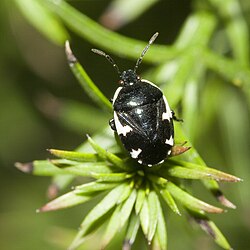- Plataspidae: Coptosoma xanthogramma , black stink bug
| Pentatomoidea Temporal range: | |
|---|---|
 | |
| Male Acanthosoma labiduroides | |
| Scientific classification | |
| Kingdom: | Animalia |
| Phylum: | Arthropoda |
| Class: | Insecta |
| Order: | Hemiptera |
| Suborder: | Heteroptera |
| Infraorder: | Pentatomomorpha |
| Superfamily: | Pentatomoidea Leach 1815 |
| Families | |
See text | |
The Pentatomoidea are a superfamily of insects in the suborder Heteroptera of the order Hemiptera. As hemipterans, they possess a common arrangement of sucking mouthparts. [1] The roughly 7000 species under Pentatomoidea are divided into 21 families (16 extant and 5 extinct). [2] [3] Among these are the stink bugs and shield bugs, jewel bugs, giant shield bugs, and burrower bugs. [4]








